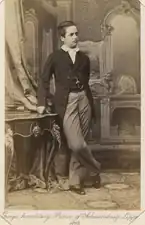George, Prince of Schaumburg-Lippe
George, Prince of Schaumburg-Lippe (10 October 1846 – 29 April 1911) was the ruler of the small Principality of Schaumburg-Lippe within the German Empire from 1893 to 1911, succeeding his father Adolf I, and being succeeded by his son Adolf II.

| George | |
|---|---|
.jpg.webp) | |
| Prince of Schaumburg-Lippe | |
| Reign | 8 May 1893 – 29 April 1911 |
| Predecessor | Adolf I |
| Successor | Adolf II |
| Born | Stephan Albrecht Georg 10 October 1846 Schloss Bückeburg, Bückeburg, Schaumburg-Lippe |
| Died | 29 April 1911 (aged 64) |
| Spouse | Princess Marie Anne of Saxe-Altenburg |
| Issue | Adolf II Prince Wolrad Prince Friedrich Christian |
| House | House of Lippe |
| Father | Adolphus I, Prince of Schaumburg-Lippe |
| Mother | Princess Hermine of Waldeck and Pyrmont |
Biography
Stephan Albrecht Georg was born at Bückeburg Castle, in Bückeburg, Principality of Schaumburg-Lippe as the eldest of four sons to Adolphus I, Prince of Schaumburg-Lippe and Princess Hermine of Waldeck and Pyrmont (1827–1910). George had seven siblings, but only five of them survived childhood.
He succeeded as Prince of Schaumburg-Lippe on the8 death of his father on 8 May 1893 and reigned until his death on 29 April 1911 at Bückeburg and was succeeded by his son who became Adolphus II.
Family
George was married on 16 April 1882 at Altenburg to Princess Marie Anne of Saxe-Altenburg, a daughter of Prince Maurice of Saxe-Altenburg.
They had nine children:
- Prince Adolf II (1883–1936)
- Prince Moritz Georg (1884–1920)
- Prince Peter (1886-1886)
- Prince Wolrad (1887–1962)
- Prince Stephan (1891–1965)
- Prince Heinrich (1894–1952)
- Princess Margaretha (1896–1897)
- Prince Friedrich Christian (1906–1983)
- Princess Elisabeth (1908–1933)
Silver wedding anniversary
On the occasion of their silver wedding anniversary in 1907, Emperor Wilhelm II presented to Georg and Marie Anne the family ancestral seat, Schaumburg Castle.[1] The castle had been controlled by the Hohenzollerns ever since Georg's grandfather sided with the Austrians in the 1866 Austro-Prussian War.[1] The gift was also meant to be in recognition of Georg's support in the dispute over the succession to the Lippe-Detmold throne.[1]
Orders and decorations
.svg.png.webp) Kingdom of Prussia:
Kingdom of Prussia:
- Knight of the Order of the Red Eagle, 1st Class, 8 January 1867[2]
- Knight of Honour of the Johanniter Order, 27 July 1884[2]
- Knight of the Order of the Black Eagle, 6 January 1894; with Collar, 17 January 1894[3]
 Württemberg: Grand Cross of the Order of the Württemberg Crown, 1872[4]
Württemberg: Grand Cross of the Order of the Württemberg Crown, 1872[4].svg.png.webp) Baden:[5]
Baden:[5]
- Knight of the House Order of Fidelity, 1893
- Knight of the Order of Berthold the First, 1893
.svg.png.webp) Kingdom of Bavaria: Knight of the Royal Order of Saint Hubert, 1893[6]
Kingdom of Bavaria: Knight of the Royal Order of Saint Hubert, 1893[6].svg.png.webp) Kingdom of Saxony: Knight of the Order of the Rue Crown, 1895[7]
Kingdom of Saxony: Knight of the Order of the Rue Crown, 1895[7] Denmark: Knight of the Order of the Elephant, 5 May 1896[8]
Denmark: Knight of the Order of the Elephant, 5 May 1896[8]
.svg.png.webp) Austria-Hungary: Grand Cross of the Royal Hungarian Order of St. Stephen, 1899[9]
Austria-Hungary: Grand Cross of the Royal Hungarian Order of St. Stephen, 1899[9]
Ancestry
References
- "Kaiser Rewards Prince", The New York Times, 21 April 1907
- "Königlich Preussische Ordensliste", Preussische Ordens-Liste (in German), Berlin, 1: 32, 1049, 1886
- "Schwarzer Adler-orden", Königlich Preussische Ordensliste (supp.) (in German), vol. 1, Berlin, 1886, p. 7 – via hathitrust.org
{{citation}}: CS1 maint: location missing publisher (link) - "Königliche Orden", Hof- und Staats-Handbuch des Königreich Württemberg, Stuttgart: Landesamt, 1907, p. 29
- "Großherzogliche Orden", Hof- und Staats-Handbuch des Großherzogtum Baden, Karlsruhe, 1896, pp. 63, 77
{{citation}}: CS1 maint: location missing publisher (link) - "Königliche Orden", Hof- und Staats-Handbuch des Königreich Bayern, 1906, p. 8
- Sachsen (1901). "Königlich Orden". Staatshandbuch für den Königreich Sachsen: 1901. Dresden: Heinrich. p. 5 – via hathitrust.org.
- Jørgen Pedersen (2009). Riddere af Elefantordenen, 1559–2009 (in Danish). Syddansk Universitetsforlag. p. 469. ISBN 978-87-7674-434-2.
- "A Szent István Rend tagjai" Archived 22 December 2010 at the Wayback Machine